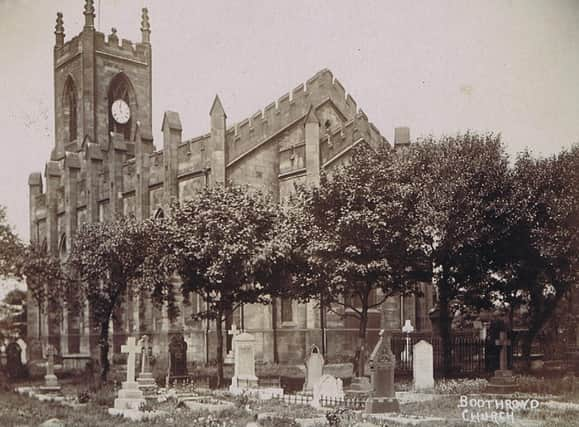Nostalgia with Margaret Watson: The death of Reverend Buckworth cast a cloud over the town for many months


I also promised to write more about its history and also more about the man who founded it in 1823, the Reverend John Buckworth, Vicar of Dewsbury Parish Church.
He also built two other churches in the same period, St Paul’s Hanging Heaton, which is still with us, and St Peter’s in Earlsheaton, which sadly isn’t.
The Reverend Buckworth came to Dewsbury in 1806 and served here until his death in 1835, achieving more in Dewsbury than any other minister.
He was a mighty preacher, who started the first Sunday school in Yorkshire, enlarged the parish church and trained missionary priests to spread the Word.
When he laid the foundation stone for St Paul’s Church more that 7,000 people stood in Hanging Heaton to hear him preach.
But, working so hard in the parish, and trying to procure new ministers for his newly-built churches, took a great toll on his health and almost certainly contributed to his early death in 1835 at the age of 56.
Throughout his ministry he was beset with great worries, none more so than the dreaded cholera outbreaks which ravaged the town from time to time and which killed many people.
Another great concern to him was getting ministers to come to Dewsbury and serve in his newly built churches for a low stipend, especially at St Paul’s.
In a letter to a friend, he wrote: “I have been much occupied, and had many trying disappointments about procuring a minister for Hanging Heaton Church.
“For nearly six months, I have been on the eve of engaging ministers but as soon as the business has come to a point, they have declined the situation, solely on account of the smallness of the income, and I shall very shortly have Earlsheaton to provide for.”
Mr Buckworth did eventually get ministers to take over the three churches, and, despite a succession of serious illnesses, he did live to see them flourish.
His death in 1835 cast a cloud over the town for many months to follow, and a monument to his memory was erected by parishioners in his beloved church, now renamed Dewsbury Minster Church.
Sadly, St Peter’s Church in Earlsheaton had to be demolished because of subsidence some years ago, and was replaced by a parish centre nearby, but this too also closed down.
The funds for the erection of these three churches were provided by Parliament under the “Million Act” when MPs approved £1m funding for the erection of churches in populous districts.
The gift of such a huge amount of money was a gesture of thanks by the government to the people of this country at the end of the Napoleonic wars.
St Paul’s was consecrated in 1825 by the Archbishop of York, and the first incumbent was the Reverend George Stringer Bull, who at the time was a curate at Dewsbury Parish Church.
He was already well known and respected in Hanging Heaton where he had been ministering to the people for some years, and they familiarly called him “Parson Bull”.
He had first arrived in Dewsbury at the height of the Industrial Revolution, at a time when children as young as six and seven were being forced to work in factories and coal mines.
Like many other churchmen in the town at the time he was pained to see the poor, half-starved children working in shocking conditions for a pittance, but “Parson Bull” decided to take action.
He condemned the system, agitating for reform, and being a strong-minded individual, soon allied himself with such radical reformers as Oastler, Sadler and Fielder, the Socialist reformer.
In conjunction with them, and others, he did much towards bringing into existence factory legislation which improved the conditions and reduced working hours for children.
When originally built in 1825 at a cost of £4,436, the interior of St Paul’s was rather plain in comparison to some village churches.
But in 1895, the year the Reverend W E Cleworth became vicar, parishioners decided to refurbish and beautify the church at a cost of £2,050 which included the interior being entirely remodelled.
St John’s Church in Dewsbury Moor had been built only a couple of years before St Paul’s, but it was already becoming well established.
The Union Workhouse, which was later to become Staincliffe Hospital, was in the parish of St John’s and it was St John’s churchyard which later became the official burial ground for those who died in the workhouse.
The churchyard is as rich in history as the church is and contains the graves of a number of important people, including that of Dr Charles Turner Thackray, who died in 1833 aged 38.
Dr Thackray was recognised as a pioneer in the fields of industrial medicine and haematology, and an early campaigner for the protection of children in mines and factories.
The epitaph on his grave reads: “After a life spent in the active practice of that profession of which he was a distinguished ornament, he fell martyr to his exertions.”
A number of distinguished people attended the church during its early days, including Charlotte Bronte, who attended services there while she was teaching at a school for girls in nearby Healds House.
Charlotte also used to attend services at Dewsbury Parish Church where her father Patrick Bronte had been a curate some years earlier.
There is much more about the history of St John’s which anyone visiting the church over the May Day weekend (April 29 to May 1) from 11am to 3pm, will discover if they call in.
Various events to mark the church’s 200th anniversary will be taking place and historical documents will be on display as well as local information of those killed in two world wars.